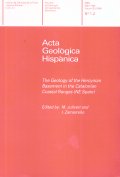El Paleozoico inferior del SE del Montseny
Abstract
The Southeastern part of the Montseny massif and the Guilleries are the areas where the oldest rocks of the Catalonian Coastal Ranges are exposed. These are also the only areas where a high grade metamorphism is found. The sequence consists from bottom to top of the following three complexes: I) fine grained leucocratic gneisses, 2) micaschists with some interlayered quartzite beds and with marbles and gneiss lenses in the lower part, 3) lower-grade metapelites and metarenites. The age has been traditionally assigned to the Cambrian-Early Ordovician. The high grade rocks are affected by an schistosy trending east-west and dipping south about 30-60'. In some instances this schistosity shows evidences of its origin from the crenulation of an older foliation. The lower grade rocks are affected by a slaty cleavage and show in addition a crenulation cleavage dipping to the south-east about 70% Three different metamorphisms can be observed in the area: 1) prograde regional metamorphism, 2) contact metamorphism and 3) retrograde metamorphism. The prograde sequence is biotite-andalucite/cordierite-sillimanite. The climax postdates the main deformation. Inside andalucite porfiroblasts staurolite relics can be sometimes observed, indicating a variation in the PD trajectory. The contact metamorphism is induced by the late granitoids and reaches the hornblende facies conditions.


